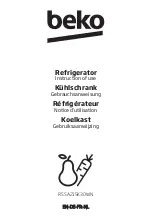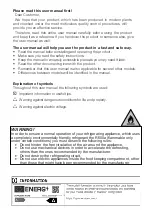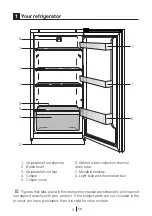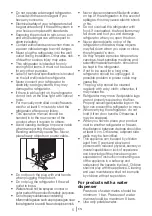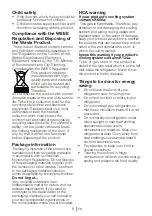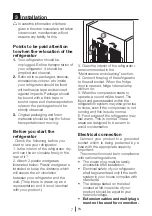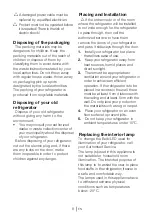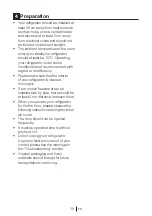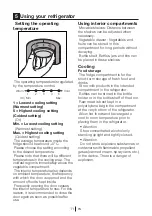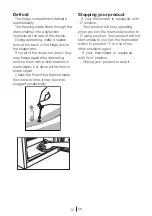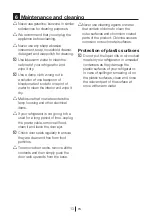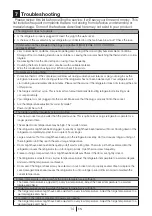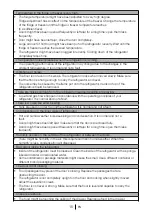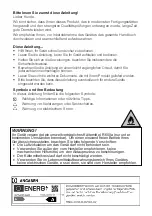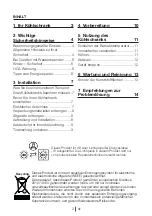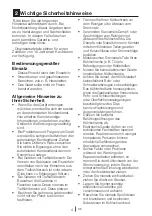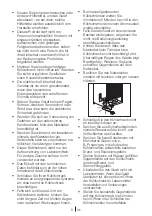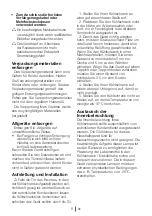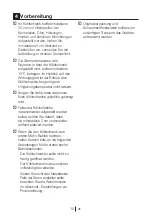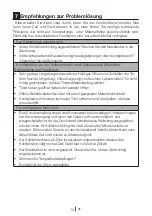
1
4
EN
7
Troubleshooting
Please review this list before calling the service. It will save your time and money. This
list includes frequent complaints that are not arising from defective workmanship or
material usage. Some of the features described here may not exist in your product.
The refrigerator does not operate.
• Is the refrigerator properly plugged in? Insert the plug to the wall socket.
• Is the fuse of the socket which your refrigerator is connected to or the main fuse
blown out? Check the fuse.
Condensation on the side wall of the fridge compartment (MULTIZONE, COOL
CONTROL
and FLEXI ZONE).
• Very cold ambient conditions. Frequent opening and closing of the door. Highly
humid ambient conditions.
Storage of food containing liquid in open containers.
Leaving the door ajar. Switching the thermostat to a colder
degree.
• Decreasing the time the door left open or using it less frequently.
• Covering the food stored in open containers with a suitable material.
• Wipe the condensation using a dry cloth and check if it persists.
Compressor is not running
.
• Protective thermic of the compressor will blow out during sudden power
failures or plug-out plug-ins as the
refrigerant pressure in the cooling system of
the refrigerator has not been balanced yet. Your refrigerator will
start running
approximately after 6 minutes. Please call the service if the refrigerator does not
startup at the end
of this period.
• The fridge is in defrost cycle. This is normal for a full-automatically defrosting
refrigerator. Defrosting cycle
occurs periodically.
• Your refrigerator is not plugged into the socket. Make sure that the plug is
properly fit into the socket.
• Are the temperature adjustments correctly made?
• Power might be cut off.
The fridge is running frequently or for a long time.
• Your new product may be wider than the previous one. This is quite normal.
Large refrigerators operate for a
longer period of time.
• The ambient room temperature may be high. This is quite normal.
• The refrigerator might have been plugged in recently or might have been loaded
with food. Cooling down of the
refrigerator completely may last for a couple of
hours longer.
• Large amounts of hot food might have been put in the refrigerator recently. Hot
food causes longer running of
the refrigerator until they reach the safe storage
temperature.
• Doors might have been opened frequently or left ajar for a long time. The warm
air that has entered into the
refrigerator causes the refrigerator to run for longer
periods. Open the doors less frequently.
• Freezer or fridge compartment door might have been left ajar. Check if the doors
are tightly closed.
• The refrigerator is adjusted to a very low temperature. Adjust the refrigerator
temperature to a warmer degree
and wait until the temperature is achieved.
• Door seal of the fridge or freezer may be soiled, worn out, broken or not properly
seated. Clean or replace the
seal. Damaged/broken seal causes the refrigerator
to run for a longer period of time in order to maintain the
current temperature.
Freezer temperature is very low while the fridge temperature is sufficient.
• The freezer temperature is adjusted to a very low temperature. Adjust the freezer
temperature to a warmer
degree and check.
Fridge temperature is very low while the freezer temperature is sufficient.
• The fridge temperature might have been adjusted to a very low temperature.
Adjust the fridge temperature to a
warmer degree and check.
Food kept in the fridge compartment drawers are freezing.
• The fridge temperature might have been adjusted to a very low temperature.
Adjust the fridge temperature to a
warmer degree and check.

